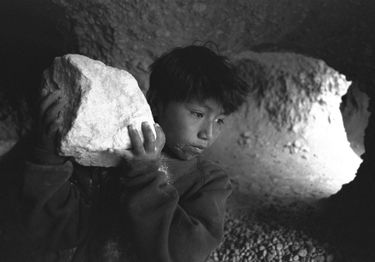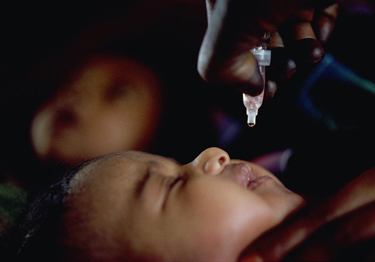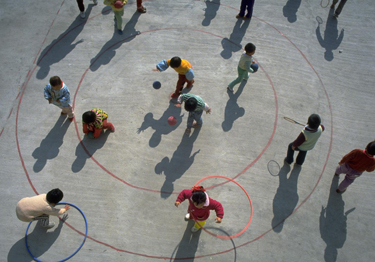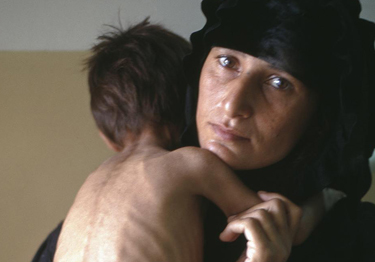About UNICEF
Using photography to advocate for children: UNICEF images from 1990-2013
| Watch a presentation that celebrates and reflects on the role of photography in advocating for children’s rights. Watch in RealPlayer |
By Ellen Tolmie
Ellen Tolmie was UNICEF’s Senior Photography Editor from 1990 through June 2013. This article is a variation on the statement she made to colleagues upon her retirement, at UNICEF House, in New York City.
This article represents the views of the author, and not necessarily those of UNICEF.
 |
| © UNICEF/NYHQ1996-0480/Balaguer |
| Miner in Peru. Millions of children around the world must work to survive. |
NEW YORK, United States of America, 3 October 2013 – This presentation of images celebrates and reflects on the role of photography in advocating for children’s rights. It spans the 23 years during which I was UNICEF’s lead photography editor.
It was a privilege and an honour to serve in UNICEF, to look at the world through the UNICEF lens and to draw on its deep knowledge about children to help shape an endlessly diverse visual story.
A photography editor’s success depends on many committed and talented photographers. This presentation also celebrates their vital contribution to UNICEF.
The images testify to photography’s power to tell a multi-dimensional story about children, to our interdependence in a world more connected than ever, and to the value of international assistance despite the inequities that continue to plague the human condition.
 |
| © UNICEF/NYHQ2009-0133/Pirozzi |
| A girl in the Gaza Strip draws how she lost her leg during an Israeli bombing raid. |
Renewing UN ideals
It has also been an honour to be part of the United Nations. I believe deeply in the UN and in the ideals on which it was founded. These need to be continually re-applied: against forces that would concentrate global power in too few hands, that foster inequity and that would lead us into more deadly wars – the most terrible waste, as also evidenced in these photographs.
Yes, the UN, now almost 70 years old, is in need of reform: we must all participate in reforming it! If the UN did not exist, it would have to be invented because our interdependent world cannot be managed without supra-national coordination. This cannot be left to only the most powerful nations or to the private sector. It is everyone’s responsibility, within and beyond the UN, and requires a reinvigorated, globally conscious citizenry that must be constantly cultivated and made itself heard.
Countering growing inequality
In the timeframe in which I worked for UNICEF, despite significant advances, we have witnessed a pronounced growth in disparities and a fraying social contract in rich, as well as poorer, countries. Likewise, the ongoing global financial crisis is a crisis of rising inequality.
Much of the present upheaval in countries around the world – for which children pay an unjust price – is caused by failed leadership in addressing inequality and in responding to the environmental crisis that threatens much of society’s and UNICEF’s and children’s gains.
This political world – the consequences of which the best photo documentarians witness every day – is also critical to UNICEF photography, because UNICEF’s work is shaped by these conditions, and its communications must respond to them. To do this, photographers must be close to their subjects, who are often in crisis, to gather the visual evidence so critical to advocating for children.
 |
| © UNICEF/NYHQ1991-0918/Lemoyne |
| Vaccination against polio in Sudan. The global campaign to eradicate this disease is inching closer to a polio-free world. |
Promoting development gains
The UN, including UNICEF, has also not sufficiently trumpeted its many vital functions and successes, including in development and human rights. Many of these are spectacular and have helped to contain or stop war, including the elimination or control of major diseases.
For example, since I began working for UNICEF in 1990, the number of deaths of children under 5 has fallen from almost 12 million to under 7 million per year [in 2011], despite population growth. Recent declines in maternal mortality rates and increased global attention to gender and to sexual violence represent a historic shift in the status of women, who remain children’s principal caretakers. Acceptance that children do have rights is also gaining ground.
These changes have come about because the world has shone light on abuse and neglect: activist, policy-making, legislative and monitoring light … and the light that records imagery.
UNICEF has played an important role in many of these successes, together with civil society, governments and other UN agencies. As the images show, many of the same challenges recur. But, improved analyses are offering better ways to respond and statistics indicate that many tragedies are less egregious in scale because of international solidarity in support of positive national and community interventions.
 |
| © UNICEF/NYHQ1992-2027/Lemoyne |
| Early childhood education in China. Play is critical to children’s physical, social and cognitive development. |
In defence of still images
Positive change requires that rights violations, and the many ways to realize human rights, be visible.
This is why UNICEF must sustain its commitment to photographic excellence to testify to the situation of children. Documentary photography is an indispensable tool for mobilizing a global constituency for children, because it presents clear evidence of their realities.
Just as UNICEF’s work in education, health, sanitation, protection, emergency response and other fields requires experts, photography, too, is a specialized craft with its own training, skills and processes. The idea that anyone can create quality photographs, or that a mediocre photograph is good enough, or that anyone can direct the consistent making or editing of excellent photography is not consistent with maintaining high standards in other areas.
Photography is also different from film and video, which utilize movement and sound. That is why the debate about the power and ethics of visual representation is centred in photography – because it is still and all image.

|
| © UNICEF/NYHQ1999-0619/Pirozzi |
| Malnourished child in Iraq. International sanctions in the late 1990s contributed to food and medical shortages in the country. |
The power of visual communication
This should all be self-evident by now. I grew up, professionally, in the late 1960s and ’70s, when everyone in media was remarking on the enormous impact of visual communication. How it was reshaping aspects of our social lives, including through the use of much more sophisticated, psychologically-tested and targeted image use for commercial advertising.
Forty years later, visual communication dominates all media, and visual marketing has spawned a global culture of consumerism. International development agencies must be just as smart – but without the gimmicks and the manipulation. People are tired of endless consumer pitches and yearn for a genuine connection with reality. We must continue examining the premises and implications of this culture of image use to harness its best potential to the cause of children.
With UNICEF’s incredible mandate, there is a great opportunity to cost-effectively support quality instead of quantity, which means sustaining the investment in professional photography.
Imagery for child advocacy
Equally important is a priority focus on communicating UNICEF’s core advocacy agenda – children’s diverse realities, needs, rights and abilities.
UNICEF must also visually document all dimensions of its programme work, in support of appropriate solutions for children and to report back to donors and secure new funding. Too often, however, the bottom-line imperative of fundraising can obscure the greater, over-arching imperative of advocating for child rights.
On the whole, this tension has served UNICEF well: its global communication presence is partly thanks to donor demands for proof of the organization’s methods and results. Nevertheless, with the increased role of private sector funds in global development assistance, there is increased risk that the balance will tip away from its primary focus.
Dignified visual representations
The photographs here attest to the power of the ‘soft sell’, presenting first the situation of children, then the what, how and why of UNICEF programme action. This approach is also the most credible and should be applied in all contexts, including emergencies, and based on images that are consistent with the dignified representation of children.
I firmly believe that clichéd representations of the child in relation to international aid and development – most frequently encountered in the ‘starving African child’ iconic image or its opposite, the ‘happy aid recipient child’ – no longer really work in raising awareness or funds for children.
But even if there wasn’t this evidence, clichéd representations are disrespectful by definition and should be excluded from development work. There is growing evidence that audiences want more nuanced approaches: a recent study in the United Kingdom of Great Britain and Northern Ireland found that people don’t want to be told simply that ‘aid works’ – they want to know why and how it works, and when it doesn’t.
Photography for child rights
I have often been asked, over the years, if I get depressed looking at so many images of suffering or neglected children. The answer has always been no. I get depressed looking at bad images, whether amateurish or clichéd or just ‘misses’.
I get angry looking at strong, moving images of children whose rights are violated because the adult world has failed to protect and defend them. This is a positive anger – to do something, to tell their story, to build awareness so that change is possible.
And I continue to be thrilled and enraptured by images that demonstrate children’s incredible resilience, ability, quirkiness and beauty. And inspired by images that demonstrate the capacity of individuals and of communities – local, national and international – to defend and advance children’s rights, even in the most adverse circumstances.
Thanks to UNICEF for the opportunity to witness this over 23 years.


